Renault finds its wild side with racy Megane
Posted on November 21st, 2018
2019 Reanult Megane RS: What You Need To Know
Get the lowdown on the latest hot hatch from Renault Sport.

Renault has launched an all-new generation of its once-benchmark hot hatch, the Megane RS, and along with new styling, it boasts a host of new technology and upgrades designed to send straight to the top of the class.
• The third-generation Renault Megane RS comes with a 1.8-litre direct-injection turbo engine – the most powerful 1.8 on the market, making 206kW and 390Nm from 2400 to 4800rpm, one of the best torque figures in the category. It’ll hit 100km/h in 5.8 seconds, matching the previous-generation RS Trophy.
• Other upgrades to the Renault-Nissan Alliance-developed powertrain include a twin-air inlet in the turbocharger and a new cylinder head design incorporating a new cooling system, located next to the combustion chamber. The exhaust system has also been revised, offering more efficiency and more of the snap, crackle and pop we like so much.
• Where the old Megane RS was only available with a manual, the new version also offers a six-speed dual-clutch automatic transmission. The shift pattern varies depending on which drive mode is chosen – Normal, Personal, Comfort, Sport or Race.
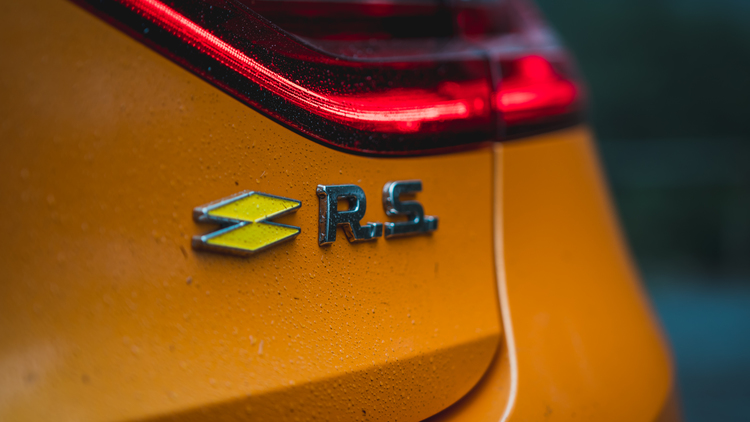
• In Race, the ESC is completely disabled and the four-wheel steering system changes its switchover point, the point where the rear wheels switch from steering in the opposite direction to the fronts, from 60km/h to 100km/h.
• One of the car’s highlights is that segment-first four-wheel steering system. Renault’s engineers started with a clean sheet for the four-wheel steering system on the RS. At high speed the front and rear wheels turn in the same direction, limited to a 1.0 degree of rotation for the rear axle. At low speeds the rear wheels turn in the opposite direction to a maximum angle of 2.7 degrees, resulting in noticeably more precise steering.
• The other new piece of dynamic tech is the hydraulic compression stops on all four shock absorbers, derived from Renault’s experience in the rally world. Essentially, it’s a ‘shock absorber within a shock absorber’ for improved ride and stability on bumpy roads. This feature was developed as a direct result of customer feedback.
• The new RS also gets a revised independent steering axis front suspension system, with a 2.0 per cent reduction in negative offset geometry – the distance between the wheel centre and the steering axis – compared with a standard Megane. The result is a more rigid front axle, reducing the effects of torque surge under acceleration
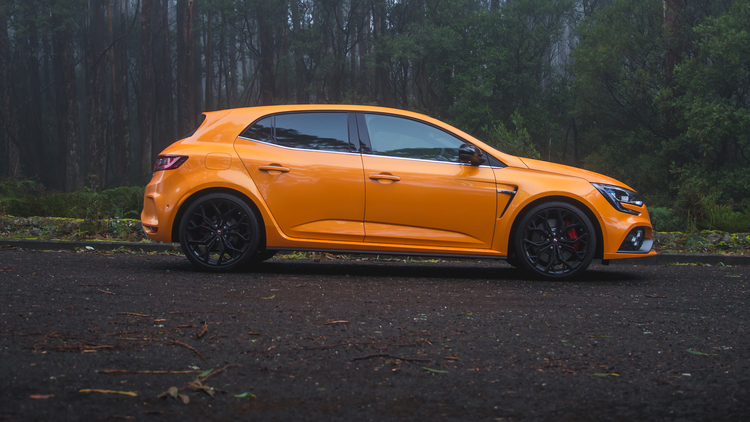
• The brakes on the latest Megane RS have been improved over its predecessor, with larger discs (up 15mm) and a more progressive brake pedal.
• In addition to the easy-to-live-with sport chassis, buyers can also option the ‘Cup’ pack alongside the manual transmission. Specific modifications include 10 per cent stiffer suspension, a Torsen limited-slip differential, and more efficient brakes with better cooling.
• There’s also a lighting system first introduced on the Clio RS. RS Vision involves three separate lighting configurations: cornering lights activated on bends up to 40km/h and fog lights, high-beam lights, or high-beam combined with fog lights. The high-beam has range of 400 metres – 17 per cent better than the previous car.
• Inside, the RS Monitor system has been redesigned. It gathers information from about 40 sensors around the vehicle and lets users view real-time data on the central touchscreen. That’s information relating to acceleration, braking, steering angle and how the four-wheel steer system is working.
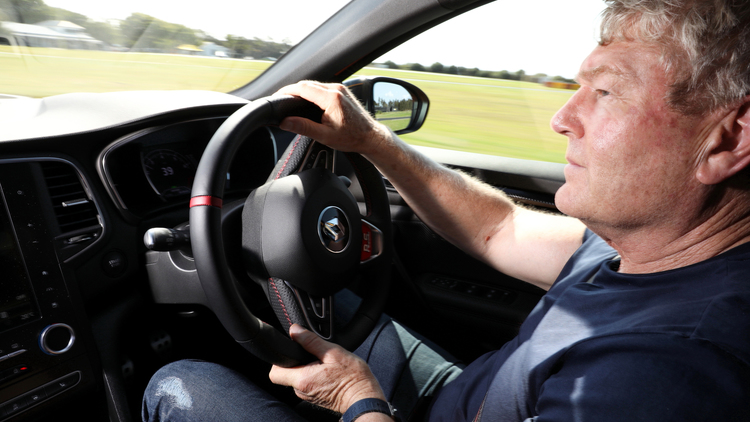
• There’s also launch control and multi-change downshifts, which works by pulling the left-hand paddle and holding it under heavy braking into a corner. The system automatically shifts the correct gear for the quickest corner exit.
• Safety kit inherited from new Renault Megane includes hands-free parking, blind-spot warning, autonomous emergency braking and adaptive cruise control. There’s also an optional Bose sound system, after feedback from owners of the previous Megane RS.
There's a lot to like about the new Megane RS, arsenal of go-fast tech and a brand new cockpit aside. It's a more mature car offering greater versatility and choice that should suit a wider group of buyers.
If you would like to test the Renault Megane - simply book online at Group 1 Renault.
Article source: https://www.caradvice.com.au/686391/2019-renault-megane-rs-what-you-need-to-know/
Posted on October 29th, 2018
Renault Clio 2019 spied: all there is to know so far
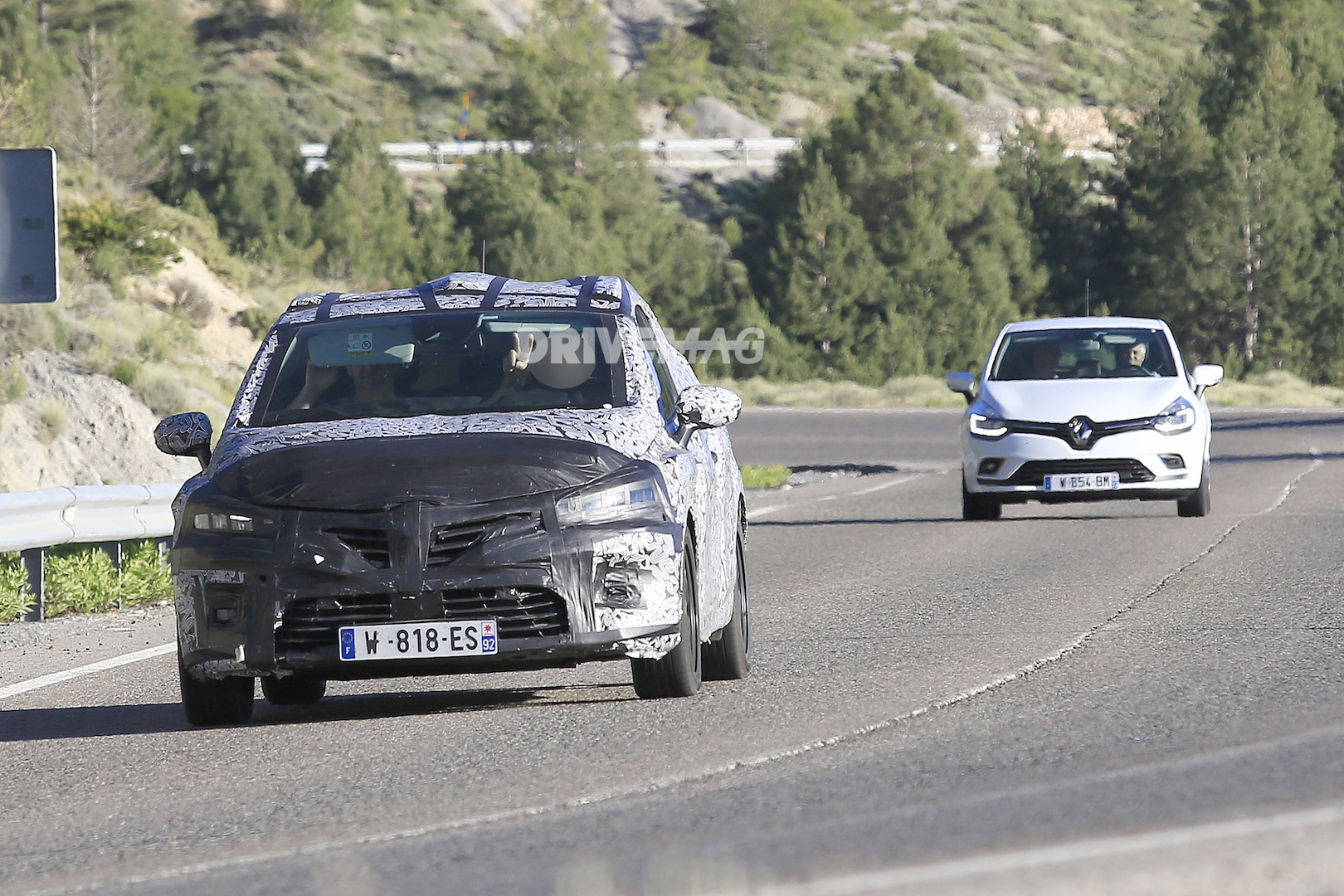
Traditionally, the Renault Clio supermini is and has been a major player in the European market. But the current Renault Clio for sale is beginning to reveal its age and Renault would be foolish not to further build on the success of its small car. To paint a better picture, last year Renault pushed 327,395 Clio models in Europe, a 4% increase over the sales volume of 2016, when Renault delivered 315,115 Clio units.
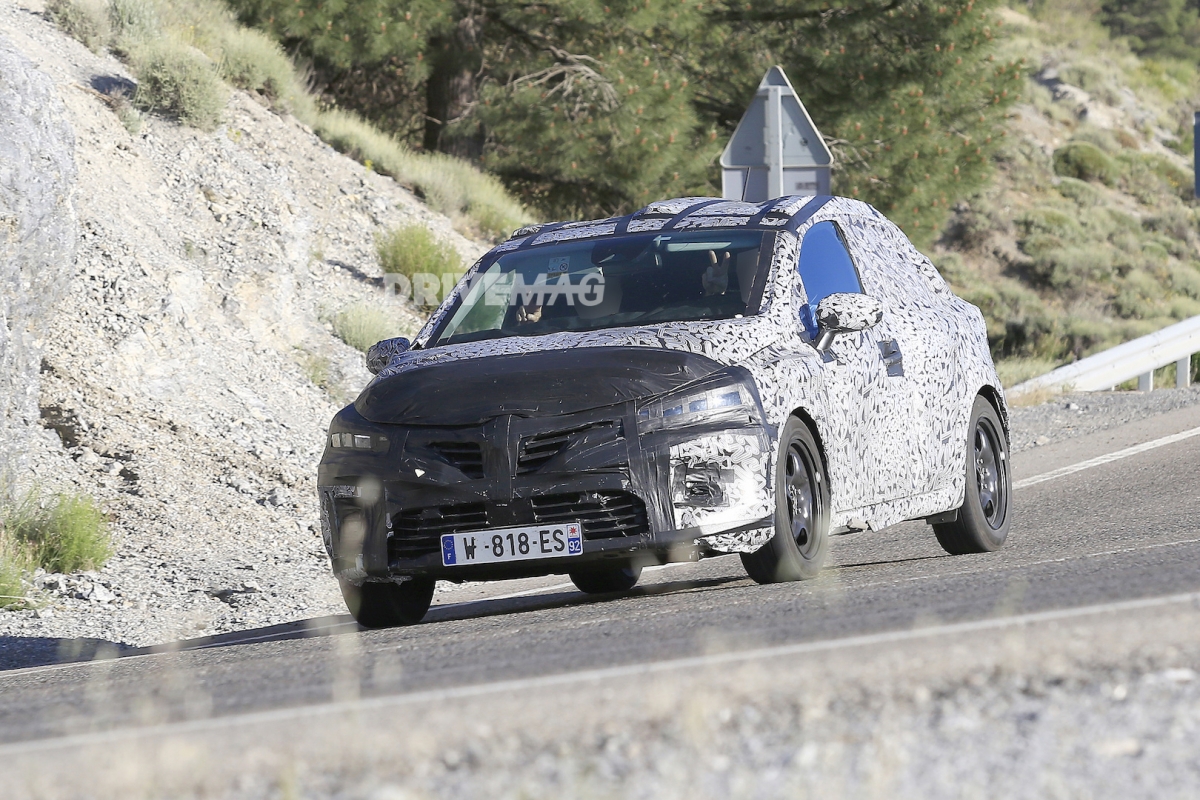
Therefore, the French carmaker is gearing up for a new model as we speak, with test mules already using public roads as testing grounds. This suggests the main R&D work is done but the usual pre-launch tweaks are next in line.
Looks and size
The spy shots we mentioned above have a Renault Mégane vibe to themselves. Although the car is wearing heavy camouflage, you can still spot the slanted hood lines, rakish roof and brooding front end.
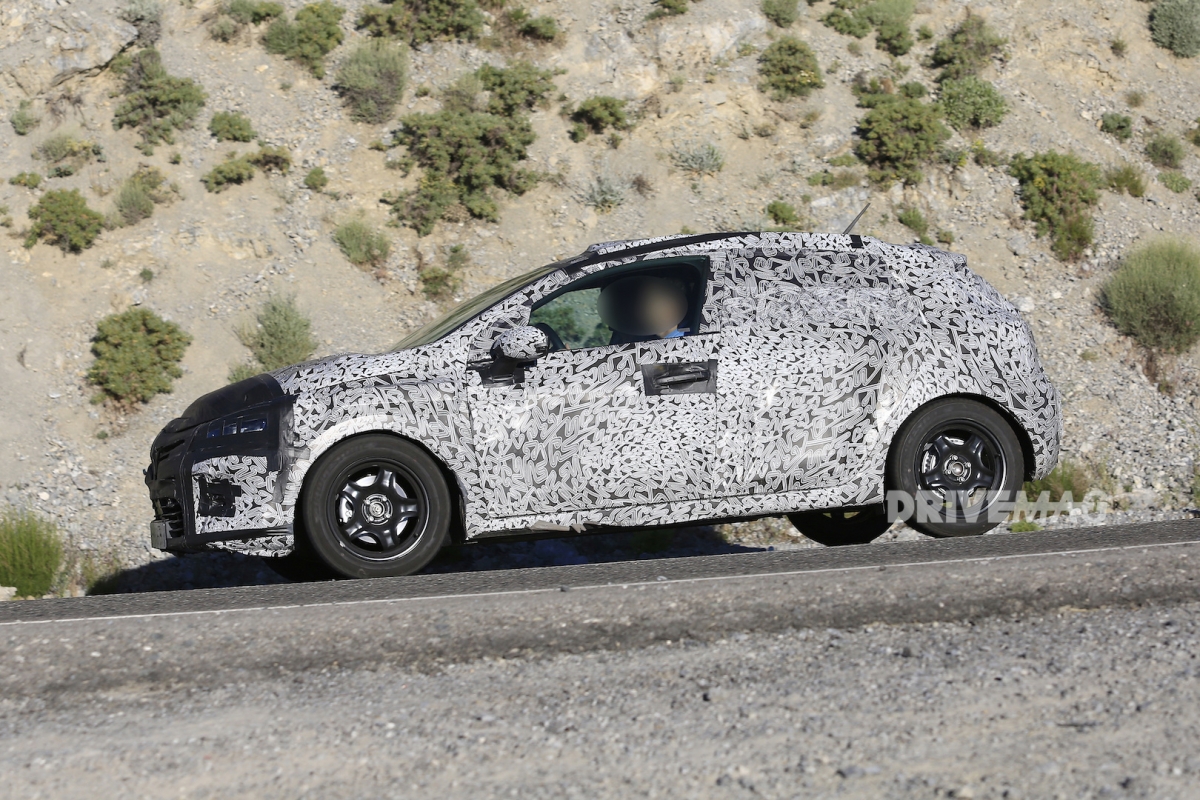
Voices say the wheelbase will grow for the Renault Clio Mk5 without dramatically altering overall length. Level 2 autonomous driving and a plushier interior for the supermini are also being talked about, but it’s too early to tell for sure.
Engine choice
As for what will sit under the hood, at this point the logical choice is the new 1.3-liter, four-cylinder TCe petrol engine co-developed by Renault and Daimler.
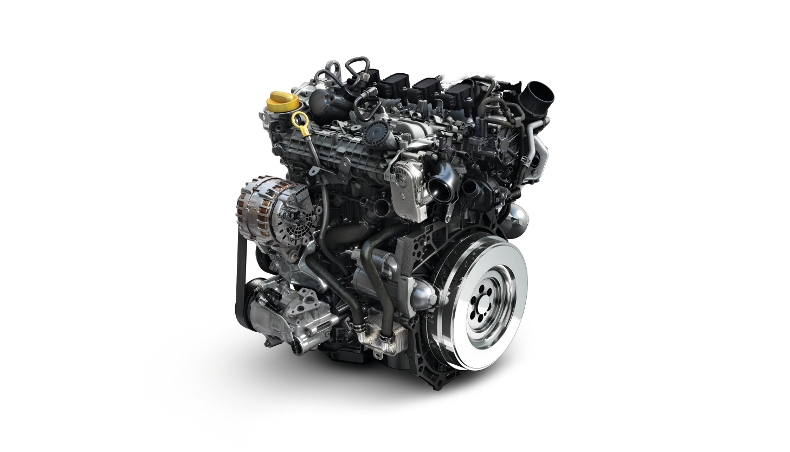
The turbocharged unit can be married to either a six-speed manual or an EDC dual-clutch transmission and is available with 115, 140 or 160 hp and up to 270 Nm of torque.

Furthermore, there’s a high chance Renault won’t drop the frugal and also popular 1.5-liter dCi power plant. Also on the engine front, a report from last year mentioned Renault would also opt for a hybrid powertrain (possibly the Hybrid Assist setup already present inside the Mégane and Scénic) that would fit inside the new Clio as well.
If you’re in the market for a great car like the Renault Clio - visit your nearest Group 1 Renault dealership to learn more about the Renault Clio for sale.
Posted on August 28th, 2018
Renault Sandero Stepway Plus (2018) Reviewed
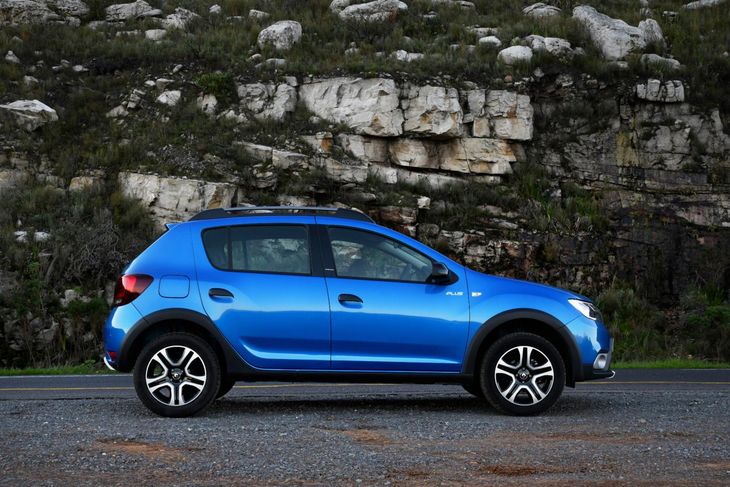
There's a slightly revised flagship version of Renault's popular Sandero Stepway on the market now. Should it be on your shortlist?
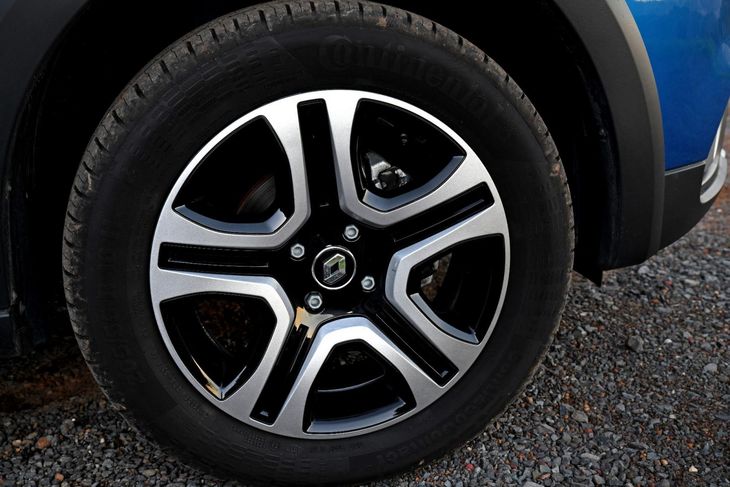
Renault has replaced its previous flagship Sandero, the popular Stepway Dynamique, with this new Plus-badged model. In recent years the Sandero Stepway has established itself as one of the best-selling compact crossovers in the market, undoubtedly as a result of its combination of smart looks, great features and a decent warranty/service plan package. But the market is considerably more competitive these days, with the likes of Suzuki and Volkswagen having pushed attractive rivals into contention with the Ignis and Polo Vivo Maxx, respectively. Can the new flagship Sandero Stepway still compete effectively?
Renault believes that style is quite an important factor in the Stepway's ongoing success and consequently this new Plus version focuses on bringing more individualisation to the party – it gets different 2-tone wheels and is offered in 2 exclusive colours, namely Dune Beige and Cosmos Blue. You can also specify it with leather and metallic paint.
What's good about it?
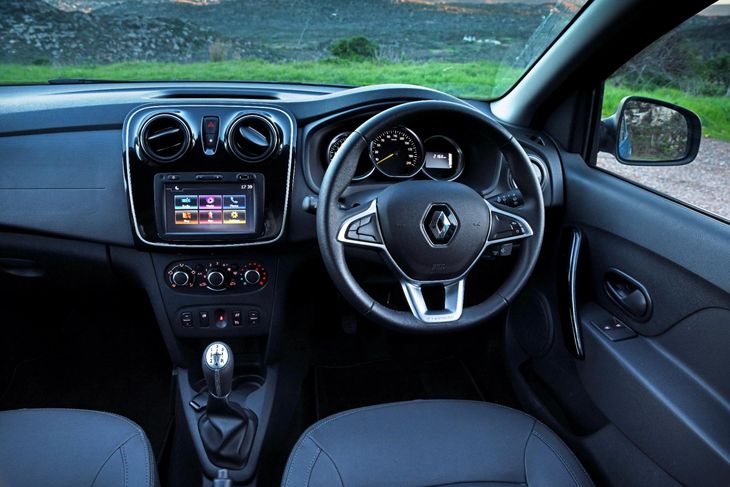
As before, the Sandero Stepway really does offer an extensive suite of features. Consequently, its appeal on the showroom floor is exceptional. You get electric windows all-round, front and side airbags (the latter not a given in this segment), air-conditioning, remote audio controls and such rarities as rear park assist, cruise control and a very comprehensive infotainment system with a 7-inch touchscreen that also incorporates navigation and a rear-view camera display.
Renault deserves applause for fitting such a "budget" offering with an exceptional array of safety features, including ESP, hill start assist and rear Isofix child seat mounts.
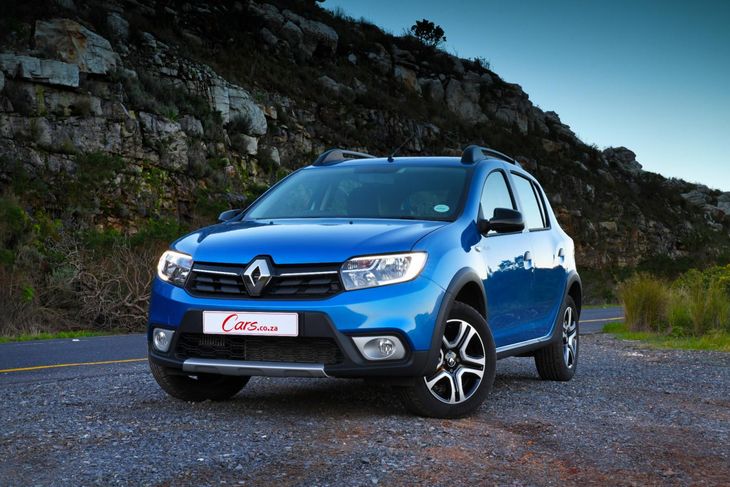
Step inside and you're also likely to enjoy the leather-wrapped steering wheel and upmarket detailing (satin-silver rimmed instrumentation and gloss black plastic finishes). Our test unit also had the smart optional leather upholstery and the recent addition of a centre front armrest will be appreciated by many.
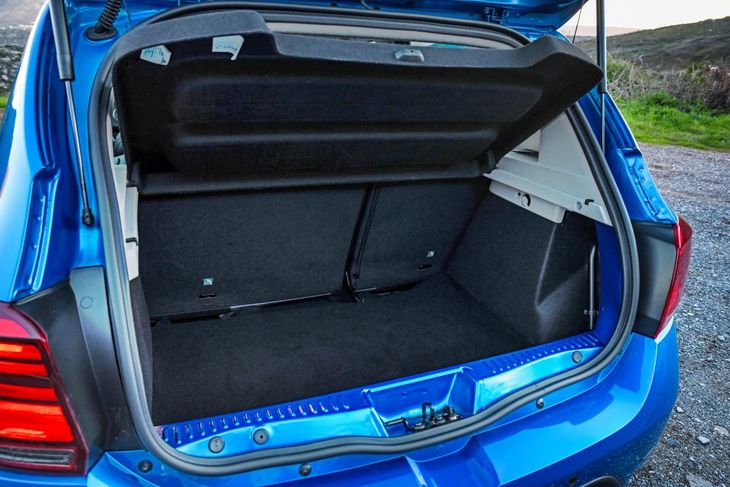
Buying a budget vehicle often means that you're getting a very small car, but the Sandero Stepway isn't. Space for occupants is good front and rear and the boot is the largest in this segment at 292L. The rear seatbacks are split 60:40 and can fold forward, should you like to transport bulkier loads.
The ride set-up of the Sandero Stepway is such that it handles the inconsistent quality of South Africa's road infrastructure rather well. The extra clearance (190 mm+) and generously "sidewalled" tyres further boost the confidence levels when the going gets a bit rough.
Warranty & Service Plan
The Renault Sandero for sale includes a 5-years/150 000km warranty and 2-years/30 000km service plan will provide some peace of mind.
.jpg)
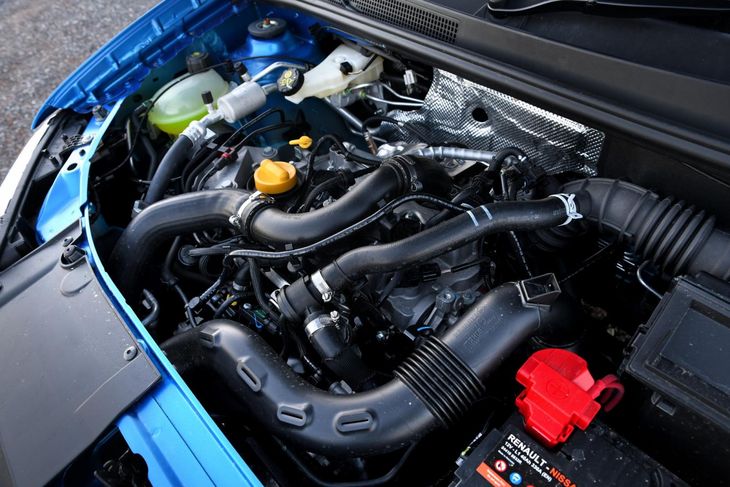
The little turbocharged 0.9-litre engine underneath the bonnet delivers an appealing blend of power and efficiency on paper, which mostly translates to the reality experienced on the road. With 66kW of power and 135Nm of torque (the latter figure from 2 500rpm), the Stepway doesn't generally feel lethargic around town, provided you stir the 5-speed 'box, and with a claimed consumption figure of 5.4L/100km, it also promises good efficiency. In reality, we achieved closer to 6.5L/100km, which is still impressive.
If you do happen to stray out of its optimal powerband, there is still some turbolag to contend with, but for the most part prolonged experience will soon see drivers adapt their driving styles. What's less impressive is the refinement of the drivetrain. We struggled with clutch modulation and smooth power delivery during out test, which made the Stepway a more frustrating drive than its rivals.
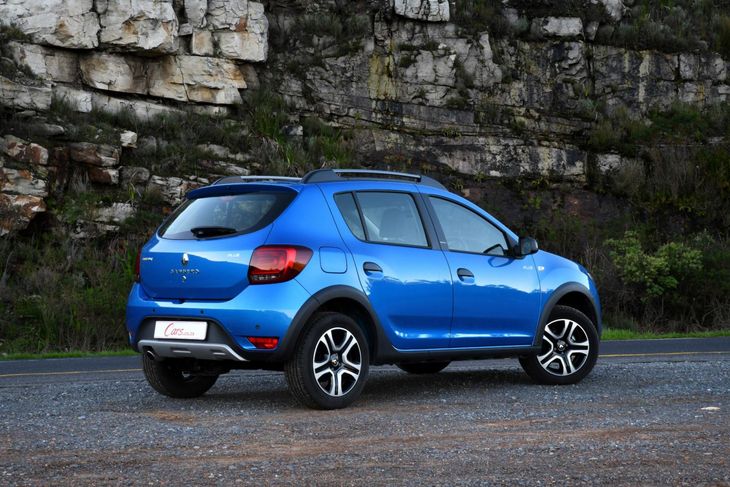
The Sandero Stepway Plus is cleverly positioned in the market and comes with very impressive showroom appeal. There is no rival product that appears to offer as much for the same price. Attractive to look at, spacious and comfortable to be in, and loaded with features, the Stepway's value for money factor is very hard to beat. There are concerns, however – the drivetrain could do with extra refinement and, perhaps most importantly, Renault needs to improve on its service levels at dealership level. Nevertheless, a 5-years/150 000 warranty will undoubtedly be enough of a sweetener for many consumers.
Looking to buy a new / used Renault Sandero Stepway?
Find the Renault Sandero for sale at a Group 1 Renault dealership near you and find out why they’re so popular.
Posted on August 28th, 2018
Renault Clio RS 18 F1: A mighty midget

Dynamite comes in small packages – and the Clio RS 18 F1 is a good case in point. What started out as a humble runabout has been transformed into a fiery hatch with very real performance credentials. But is its talent set broad enough to allow for everyday motoring, too?
Small hatchbacks are a dime a dozen, and they represent a large slice of passenger vehicle sales in South Africa. The reasons aren’t hard to find: they’re relatively affordable and economical, while their compact dimensions make for easy road manners.
The Renault Clio is a typical example, but it confidently exudes a welcome individuality that’s often sorely lacking in mainstream hatchback designs. Even base model versions look smarter and sexier than the norm.

There’s more to Renault – and the Clio – than mass-market models. The French brand has a long tradition of motorsport success, spanning anything from rallying and one-make racing to Formula One. Renault’s in-house performance division, Renault Sport, ensures that some of that motorsport expertise filters down into its production models under the RS (for Renault Sport) moniker. The Clio RS 18 F1 is one of the most recent additions to the RS stable.
The rather clunky designation is a reference to Renault’s 40-year history of involvement in Formula One, which harks back to 1988. It also happens to be the same nomenclature as the current Renault F1 car campaigned by Nico Hulkenberg and Carlos Sainz.
To be honest, the link between the F1 car and this hot-hatch Clio is a little tenuous. The Clio RS 18 F1 has a black-and-yellow colour scheme inspired by the F1 car’s livery. And both cars are powered by 1.6-litre turbo engines. But really, that’s where all similarities end.

In essence, the RS 18 F1 is a limited-edition version of the standard Clio RS220 Trophy. In technical terms, it means the little hatch gets a bespoke four-cylinder turbo engine fettled to deliver a wholesome 162kW of muscle.
Add the 280Nm of torque, factor in a kerb mass of only 1,172kg, and you have a recipe for real get-up-and-go. The gearbox is a six-speed dual-clutch design, feeding the engine’s urge to the front wheels.

What? No manual transmission option? Purists will be disappointed, but dual-clutch gearboxes tend to be more efficient, while those shift paddles do endow gear changes with a racier feel.

The cockpit is racy, too. Black is the dominant hue, with crimson detailing and some aluminium brightwork (including alloy pedals) adding some welcome visual interest.
The heavily bolstered bucket seats feel firm but comfortable, while the thick-rimmed steering wheel neatly frames analogue dials and a digital speedometer. The large shift paddles behind the steering wheel are fixed, by the way, and don’t rotate with the steering wheel.

It may be F1-inspired, but there’s no shortage of creature comforts in the RS 18 F1’s cabin. The centre stack is home to a 7-inch touchscreen that looks after the Clio’s full-house infotainment system.
Apart from Bluetooth-based hands-free telephony and audio streaming, there’s also satnav, FM/AM radio, USB and stereo jackplug connectivity. Add aircon, remote central locking with keyless access, cruise control and heated seats, and the RS ticks most of the nice-to-have boxes.
The problem with performance-focussed road cars like this Clio RS is that they can often end up being compromised from a day-to-day driving perspective.

While it’s fun to head for the hills on an early weekend morning, and to blast the cobwebs away on a quiet country road, most RS owners will also need to commute, fetch and carry kids, and embark on the occasional long-distance holiday trip.
Here’s the good news: the Clio RS might look like a three-door, but it actually has two rear doors, with the door latch cleverly concealed in the C-pillar. Rear seating is less cramped than expected, too, making the little Renault a lot more practical than expected.
At 300 litres, the boot isn’t huge, but it’s useful, and you can always fold the split rear bench seat flat to increase cargo space if necessary. Plus, the Clio is one of the safest hatches in its class, with a five-star Euro-NCAP rating and a raft of active and passive safety features.


Hit the start button, and the bespoke Akrapovič exhaust system’s resonant vocals act as an instant reminder that this is a performance car first and foremost. It’s a sound that suits the RS persona, but can be intrusive.
The 1.6-litre turbo engine is a delight, revving to the redline with alacrity, and producing plenty of shove. In absolute terms, 6.6sec for the 0-100km/h sprint is swift rather than race car rapid, but the Clio’s reactions to throttle, brake and steering inputs are certainly incisive, and the line of communication between car and driver is unambiguously direct.
It scorches off the mark with real glee, while in-gear acceleration is equally enthusiastic. The lower, stiffer suspension ensures you know exactly what the Clio is doing, and despite its electric assistance, the steering feels reasonably communicative.

This is a car that loves attacking sweeps and bends, curves and corners, fast or slow, wide or narrow. It slices through mountain passes with surgical precision, while maintaining exceptional levels of composure and control.
It’s not so much about driving fast in the Clio RS as it is about exploring the car’s agility and wieldiness. No matter how sinuously treacherous the ribbon of tar being negotiated is, the Clio sticks to the chosen line with thrilling tenacity.

At this point, it’s worth mentioning that the RS 18 F1 has three driving modes: Normal, Sport and Race.
Normal is meant to be for day-to-day use, and softens the hatchback’s reactions. Sport should be the default setting, ensuring crisp throttle response, a heftier helm, and snappier gear changes.
Opt for Race mode, and you can use launch control to propel the Clio off the line with optimum alacrity, while the stability control’s electronic safety net is cast a little wider, allowing more slip and drift (ie more fun) before it intervenes.

The EDC gearbox is at its best in Sport mode, delivering the quick and precise shifts you’d expect of a performance car. Using the shift paddles is a must though, adding further driver engagement and driving enjoyment.
In the normal setting, the gearbox can be a little hesitant, however, especially in the lower three gears. Opting for full auto mode is useful in stop/start traffic, but the Clio never feels completely at ease in those conditions, and assuming manual control remains the better option.
Compared to a bread-and-butter Clio, the taut suspension and low-profile tyres definitely compromise ride refinement. And at highway speeds, there’s a lot more road and engine noise to contend with.

That said, I’d be disappointed if that wasn’t the case: you want this car to look, to sound, to feel the RS part.
The collectability of the RS 18 F1 version, and its unique livery, are also significant drawcards. And on a purely practical level, the Clio can go about its commuting business as competently as any average Clio.
Best of all, the Clio RS driver is likely to have more day-to-day driving fun than owners of exotics or hugely powerful muscle machines. Those cars have to be driven at levels beyond the scope of normal road conditions to be fully appreciated.
The Clio RS can be flung about at far more pedestrian speeds, and still be enjoyed to the full. It offers a lot of entertainment value, even in day-to-day driving.
Add five-door practicality, five-star safety and reasonable running costs, and suddenly, the Clio RS 18 F1 makes a lot of sense –if you’re a petrolhead with an appetite for adrenalin, that is.
The Clio RS is a lot of driving fun in a surprisingly practical package. Test drive the Renault Clio RS at your nearest Group 1 Renault dealership.
VITAL STATS
Engine | In-line four cylinder, 1,618cc, turbo |
Power | 162kW @ 6,050rpm |
Torque | 280Nm @ 2,000rpm |
Power-to-weight ratio | 138.2 kW/ton |
Gearbox | Six-speed EDC dual-clutch, FWD |
Wheels/tyres | 18-inch alloy, 205/40 R18 tyres |
0-100 km/h | 6.6sec |
Top speed | 235km/h |
Fuel tank capacity | 45 litres |
Fuel consumption (claimed/tested) | 5.9 / 7.9 litres/100km |
Operating range (claimed/tested) | 762 / 570km |
CO2 emissions | 135g/km |
Posted on August 28th, 2018
Sandero Stepway is great value

And on that note, the Stepway is more budget-friendly than ever following its recent mid-life facelift.
In fact, the view ahead is quite pleasing, with its combination of carbon-like trim, chrome surrounds and grainy plastics that are hard but look soft. It’s not as classy lower down and to the sides, and the glovebox on our unit was out of alignment with the dash, but other than that the build quality and finish seemed acceptable at the price.

Ergonomics have also improved with the latest upgrades, the hooter migrating back to its rightful place on the steering wheel and the front electric window controls hopping from the centre console to a far more convenient location on the door panels. The aforementioned MediaNav touch-screen system is also a cinch to operate.
Despite the car’s fairly generous proportions, there isn’t really a lot of space for rear seat passengers to stretch their legs, although the 292 litre boot is big by class standards.
Unfortunately it is quite laggy through the lower reaches of the rev range, which makes it trickier to pull off, and take gaps in traffic. You really have to stir the five-speed manual gearbox frequently and as a result it’s not as effortless to pilot as normally aspirated rivals such as Toyota’s Etios. That said, when you’re in the rather narrow power band the little engine does deliver very decent-for-its-class performance.

Even if you have to rev it a bit higher than the economy gurus would recommend, fuel consumption remains impressively frugal, our test car averaging 6.7 litres per 100km on an urban-heavy mixture of town and freeway driving.
Chucking it around the urban grind, it’s not only the engine that detracts from its ease of use - there’s also no place for your left foot next to the clutch. The rest of the driving experience was rather painless though and despite a lack of seat height or steering wheel reach adjustment (albeit understandable at the price), I was able to find a comfortable driving position.
With a ground clearance of 193mm, the Stepway rides higher than the normal Sandero hatch, but it doesn’t feel too top-heavy around corners. Its stance might help it out on the dirt roads, but like most of today’s crossovers and SUVs it’s no off-roader, although those black wheel arch mouldings, bulky bumpers, skid plates and roof rails ensure that it most certainly looks the adventurous part.

By the way, its wheels aren’t actually real alloy mags, but you’d have to give them a good nudge to tell the difference. They’re steel wheels carved in the same shape as the smartly designed plastic hubcaps that cover them, so you don’t see the steel rim at all. They’re not only a lot cheaper to make than alloys, but also more cost effective to replace if you scrape them on a rock while trying to prove that the Sandero is in fact an off-roader (which you shouldn’t). Genius.
VERDICT
Compared with its rivals the Sandero Stepway has a cleaner, fresher look to it and it’s better equipped and cheaper. Providing you can live with its few quirks, it is most certainly an excellent and very desirable buy in its seemingly confused segment. But then if you can go without those trendy pumped-up looks and a few of the gadgets, its conventional hatch sibling, the Sandero Expression, is an even better deal - possibly even one of the best on the market right now.
FACTS: Renault Sandero Stepway 0.9T Dynamique
Engine: | 0.9-litre, 3-cylinder turbopetrol |
Gearbox: | 5-speed manual |
Power: | 66kW @ 5250rpm |
Torque: | 135Nm @ 2500rpm |
0-100km/h (Claimed): | 11.1 seconds |
Top speed (Claimed): | 168km/h |
Warranty: | 5-year/150 000km |
Maintenance plan: | 2-year/30 000km |
If you’re looking to get your drive on a new or used Renault Sandero - make sure to contact a Group 1 Renault near you. Book a test drive and discuss the Renault Sandero specs with a knowledgeable staff member at Group 1 Renault.
Posted on June 15th, 2018
Renault Duster review







On the face of it, the pitch made to the market by the Renault Duster is so outrageous, so bold, so seemingly implausible that your first thought is to find the catch, which instinct tells you simply has to be there.
The fact is this: buy a new Duster and you'll find a good looking compact SUV with a spacious interior, for not much money, parked outside your house. It's cheaper than a Ford Fiesta, and the diminutive Smart car. It’ll only cost marginally more than Fiat’s asking price for the cheapest Panda, for goodness sake. The cheapest Skoda Yeti featuring an engine of identical power to that of the entry level Duster costs notably more.
Moreover the base ‘Access’ grade comes only with 1.6-litre petrol power so if it’s diesel you want you’ll need to hop up to mid-spec ‘Ambience’ which, model for model is a further four-figure chunk of change and even that won’t buy you air-conditioning or alloy wheels. If you want such items as many might these days be regarded as basic essentials, you’ll need the top of the range ‘Laureate’.
Then again even this most dashing Duster of all still costs less than the skinniest Skoda Yeti.
Were this Duster like the last one, which went on sale here briefly at the end of the 1980s, perhaps the pricing would be understandable. But it’s not an automotive excrescence so terrible it makes a bus pass look attractive, it’s an apparently credible product made in a state of the art factory in Chennai, India out of largely Renault and Nissan components.
Which is why Jean-Christophe Kugler, Executive Vice President of Dacia, is so pleased with the range of as he coins it 'reliable, user-friendly cars that are affordable as well'. Speaking at the 2016 Paris Motorshow, Kugler explained that the effort to improve the appearance and ergonomics hasn't ballooned the price with prices across the Renault range increasing by a mere two percent over seven years.
Design and styling






The Duster sits on the Renault-Nissan B0 platform which, for the avoidance of doubt is B Zero, not a personal hygiene issue. Relative to the Yeti to which it would so love to be compared, it’s a little longer, wider and sits on a larger wheelbase so whatever you’re losing, it’s not metal for the money.
The 2017 update has seen the Duster get a more distinctive exterior, with the new front grille dominating alongside an upgraded headlight system and bumpers. Inside the interior has been improved both in terms of quality and ergonomically, to allow it to retain its position as a compelling choice for those looking for a cheap, rugged small SUV.
The platform mandates the use of traverse engines, in this case a 1.2-, 1.6-litre petrol or a 1.5-litre turbodiesel. The entry-level 1.2-litre petrol engine has 123bhp while the bigger capacity 1.6-litre petrol produces a miserly 112bhp and the diesel produces 107bhp. For the first time, the Duster will also receive Renault's EDC dual clutch automatic gearbox, a decision driven, Kugler says, by the increase in sales of automatics - especially the dual clutch variety and the limited effect it has on emissions.
Should you choose a 4x4 version, the all-wheel drive system comes courtesy of Nissan and provides three modes: front drive, permanent four-wheel drive or ‘automatic’ that that switch between the two according to need.
Cleverly these Dusters also come with an unusually low first gear ratio in place of a heavy, complex and expensive low ratio transfer box for off-roading.
As you might expect the suspension of front drive Dusters varies not at all from the class norm with struts at the front and a torsion beam rear axle. However four-wheel drive models receive an independent four link rear end that provides better wheel control and, in theory at least, superior ride and handling, in exchange for a substantial 67 litre reduction in boot capacity.
A word now about safety. For years now there has been an almost automatic presumption that any major new car from a major organisation competing in the market mainstream (Dacia has been owned by Renault since 1999) would almost inevitably earn a five star EuroNCAP crash rating. Not the Duster, which received a three star rating when tested in 2011.
Dacia says this is because the overall star rating cannot exceed the rating for the worst component of the test and it was clobbered in the ‘safety assist’ category by the test vehicle lacking stability control. It contends that had the car been so equipped (an option on diesel Dusters but not available on petrol cars), a more conventional, but still unimpressive, an overall four star rating would have been recorded.
Scratch the surface though, and you'll see a car that recorded four stars for adult protection, five stars for child protection and four for pedestrian safety.
Interior






Peer into the Duster’s cabin and while you’re not going to conclude that the Promised Land now lies before you, you're unlikely to throw your hands up in horror. The interior looks perfectly pleasant and proficiently styled, even if a little grey. We say ‘looks’ because your fingers will not be rewarded by probing away too diligently at the largely rock hard plastics of many different textures.
For a car in which right hand drive appears an afterthought – it took two years for Dacia to get around to making it – the fundamental driving position is actually quite reasonable. There’s no reach adjustment on the steering wheel which is disappointing and taller drivers will find it’s too far away, but the relationship between seat, driver and pedals is acceptable.
Offering air-con only on the priciest models dents the Duster's value appeal
You sit high in the car in time-honoured SUV style and while the driver’s seat is height adjustable the squab itself is flat, short and shapeless providing no more than adequate comfort over longer distances. Likewise the Renault's side bolsters, whose lack of support is mitigated only by the fact the Duster is not a car that’s ever going to generate substantial lateral g.
Ergonomically it’s there or thereabouts. The switchgear is not pretty and the ventilation controls are set a little too low but it’s never a problem to identify and operate whichever dial, switch or button you need. All round visibility is excellent too. It’s worth remembering however that air conditioning is available only on top spec Laureate models.
And by class standards the Duster is quite spacious too. There’s room in back and front for four average adults to travel in peace. The only short straw will be drawn by the fifth person on board. Not only will he or she be perched uncomfortably on a pad between the rear seats, but the centre seat belt arrangement, which has its upper mounting point far behind you on the C-pillar, is sub-optimal not just for you, but the person sitting to your left.
Predictably, given the price, there's not a great deal of equipment on the basic Duster model - but you do get power steering and remote central locking. Opting for the Access trim gets a bit more equipment, mainly in the shape of bigger steel wheels, electric front windows and height adjustable rear headrests. Move up to mid-spec Ambiance trims and suddenly the Duster gets a lot more modern, with kit including fog lights, DAB radio, Bluetooth and USB connectivity, while for 2016 the Ambiance Prime spec added a bit more luxury, including an exclusive metallic paint job and 16in alloy wheels.
The range-topping trims - Laureate and Prestige both offer 16in alloy wheels, air conditioning, electrically adjustable and heated wing mirrors, and convenience lights throughout the interior as standard, while the latter also includes a 7in touchscreen infotainment system with sat nav and traffic updates, a reversing camera and rear parking sensors within the package.
The Duster also has a decent boot: if it's just pure space you want, at least in the two wheel drive Duster, there’s more space than you’ll find in the Yeti, Nissan Qashqai and even the Range Rover Evoque. Seats down and load area is comparable to that of an Audi A6 Avant.
Performance



The Renault Duster is lighter than you’d think, with even the diesel model weighing just 1205kg (though this rises to 1294kg with four-wheel drive). On paper there appears little to tell between petrol and diesel performance but in the real world diesel will likely prove the preferable choice every time - not just because of the extra range and fuel consumption it provides.
It weighs in at 1kg more than the latest Renault Sport Clio.
This is not the kind of car you’ll ever be likely to drive to the limit of its performance potential so what matters in everyday life is that the engine responds keenly to each press of the pedal, no matter what revs the engine is pulling.
This is territory the ubiquitous Renault/Nissan 1.5-litre diesel knows well. It has excellent low down torque although, even by diesel standards, it gets breathless very quickly at the top end.
There’s little turbo lag and always a strong response to your commands, aided by the slightly notchy six speed gearbox that nevertheless has all points of the Duster’s power curve nicely covered.
A shame then that in the Duster installation the diesel is intrusively noisey at all speeds from idle to redline. In most such cars you accept a degree of clatter when the engine’s cold or under load but so too should you be able to expect it quieten down to a point where it’s nearly inaudible at a cruise. In the Duster this never happens.
Ride and Handling


ou get the impression that the provision of decent handling and ride were not among the options presented to Renault’s chassis engineers by the raw material at their disposal. Drive the Duster, at least the front-drive Duster with a beam axle at the back, and you can almost see the thought process that followed. Probably correctly ride comfort has been prioritised and as a result the Duster chassis actually seems superficially quite sophisticated at first, sponging away everyday lumps and bumps like a seasoned pro.
Its suspension set-up, though rudimentary, fits the car's billing. But there is a price to be paid: while the soft springs may keep such intrusions from shuddering through the cabin, the same cannot be said of the steering which feels like it has a less-than-rigidly mounted rack.
It provides the unlikely and unfortunate combination of substantial kickback through the rim with almost zero feedback - precisely the reverse of what you might choose.
And those soft springs also affect primary ride comfort with quite pronounced roll rates evident on country roads and notable heave and wallow over crests and into dips.
Braking ability is reasonable: the pedal is a little spongy and ultimate retardation feels limited by the amount of forward weight transference created by those soft springs, but ABS actuation is sensibly delayed and the system itself is fade free in all normal use.
Verdict

you cannot ignore the pachyderm sitting patiently in the corner. The Duster is an attractive, spacious and, with diesel power, a relatively frugal SUV available for much less than you’d expect. Its proposition to the marketplace is truly remarkable and so long as you go into the dealer knowing the car you’re looking at is far from the state of the art, certain allowances can be made.
The Renault Duster is a proposition unlike any other on the market. It may be based on some old technologies and it certainly has its flaws, but it is relevant, effective and cheap.
In our eyes and those of the thousands all over Europe who’ve turned it into such an astonishing success and will doubtless now do the same in Britain, that is what counts for most.
Group 1 Renault has the Renault Duster on offer. Test drive a Renault Duster and experience the Renault magic!
Article source: https://plus.google.com/b/114869080955733974351/114869080955733974351/posts/Du9SB13uVrK
Posted on May 8th, 2018
Renault Clio - Honest Motoring Review



IT IS always exciting when you get to test drive a hot hatch, but with the Renault Clio RS 200 EDC, it has been different.
You see, I am the owner of a previous-generation Renault Clio for sale, so when I heard how the DNA of the new version had been altered, I began to worry. But I came into the test with an open mind; I had driven all of its rivals enough to make an informed decision.
The most fuss was about the free-revving 2.0-litre naturally aspirated engine being replaced by a 1.6-litre turbocharged unit. It has the same claimed output figure as its predecessor (147kW), albeit now with 240Nm of torque. The six-speed manual gearbox is gone and in its place is a six-speed twin-clutch automatic. There is also only a five-door option now, whereas the third generation was a three-door. The Brembo brakes have also been done away with.
Why would a manufacturer famed for its pure performance hatches do this? Sales. Some of the best-selling hot hatches on the market are the Volkswagen Golf and Polo GTI models, which are mostly also double-clutch automatics. The other thing is that they are locally also five-door-only models. The Clio has taken this recipe for sales success by downsizing in terms of mechanicals and upsizing in terms of practicality.
The gearbox is not very impressive in normal mode - it holds gears for too long and then drones as it changes, but RS Sport mode remedies this problem. The sport setting means that the traction and stability programmes are still on, but they are progressive and only intervene when it is absolutely necessary.
For those who want the pure driving experience, race mode means no traction control and manual shifts via the steering-mounted paddles. The upshifts are truly very quick, but on downshifts the gearbox hesitates to respond to your inputs, which in a track situation could prove frustrating.
We had the Cup spec, which does what it says on the box: the car is lower and can corner better than its Lux sibling, but does sacrifice in terms of comfort.
The straight-line stuff is where the Clio RS is very impressive. A 0-100km/h time of 6.7 seconds is achievable thanks to a brutal launch-control system. I found the claimed fuel consumption of 6.3 litres/100km difficult to replicate. On a mixed cycle, I could only muster a figure north of 8.0 litres/100km, which is still more efficient than the model it replaces.
Overall I have to say that I liked the new Clio RS quite a bit more than I thought I would. You get the sense that this vehicle was well thought out from a marketing perspective. It has all of the necessary ingredients to appeal to the boy racer market, yet is also something that anyone would be happy to drive as a daily.
I think that it’s only real rival is the Polo GTI, as it’s the only auto-only model in this class and therefore appeals to a different market. As a daily driver I can’t say that I wouldn’t prefer the Renault with a newly found maturity.
If you’re interested in and want to know more about the available Renault Clio’s on offer - contact a Group 1 Renault dealership today. Their capable and knowledgeable staff look forward to assisting you from booking a test drive to buying a Renault Clio for sale.
Article source: https://www.autodealer.co.za/new-cars/Renault/Clio-RS
Posted on March 22nd, 2018
Review: Renault Sandero Stepway
The new Renault Sandero Stepway, however, is an infinitely superior vehicle to its predecessor. One expects manufacturers to incrementally improve their wares with each generation, but with the latest version of the Stepway, Renault has does more than just that — the urban crossover has taken giant leaps forward in virtually all departments. And the best part of it all? The second-gen Stepway's pocket-pleasing price-tag has hardly changed.
Perhaps most impressive is the Stepway's standard specification list, which includes a number of features that are pretty unusual in the budget segment. It boasts rear parking sensors, cruise control (with a speed limiter), Bluetooth, leather steering wheel (with tilt-adjustment) and satellite audio controls, as well as an electronic stability programme, traction control, hill-start assist, emergency brake assist, and four airbags.
In addition to these handy items, the Stepway also features all the kit one would expect from such a vehicle, including electric windows, air-conditioning, a multi-information display, audio system (CD/radio/USB/Aux), electrically adjustable side-mirrors, front fog-lights, a 60:40 split folding rear bench, IsoFix child-seat anchors, and ABS with EBD.
The styling is similarly pleasing, allowing the Renault Sandero Stepway to come across as more premium than it actually is. In fact, we reckon this crossover version — with its subtle black cladding, raised ground clearance (up 29mm to 193mm), front and rear scuff-plates, and silver roof-rails — is a fair bit better looking than the standard hatch on which it is based.
Of course, the Stepway shares its powerplant — an 898cc turbo triple we first sampled in the Renault Clio 4 — with the self-same Sandero. This forced induction three-potter makes a credible 66kW at 5250rpm and 135Nm at 2500rpm (besting the previous generation's naturally aspirated 1.6-litre), which the French automaker reckons is good for an 11.1-second dash to 100km/h.
In reality, though, the Sandero Stepway feels a little sluggish at the bottom of the rev-range, even if the fuel-saving Eco Mode (which dulls engine response for the sake of efficiency) is disabled. This lack of punch compels the driver to push a little harder, resulting in a menacing three-potter thrum as the revs rise, as well as a general decrease in fuel efficiency.
Although we didn't manage to match Renault's consumption claim of 5.4 litres per 100km, we were nevertheless left impressed by our final figure of 6.1 — which translates into a theoretical range of well over 800km from the 50-litre tank. Bear in mind, however, that in top gear the small capacity engine spins at a rather lofty 3000rpm at 120km/h.
The shift action of the five-speed manual gearbox, meanwhile, is disappointingly flimsy and the ride a little choppy over scarred tarmac. In fact, chuck the Stepway around and it feels decidedly unsettled thanks to the appreciable increase in ride-height. But customers buying a Stepway are likely to care more that it can take poor road surfaces in its stride than that it doesn't corner particularly flat.
Inside, the Stepway comes across as hard-wearing but without looking "cheap and nasty". The layout of certain controls, however, takes some getting used to (the front electric windows, for example, are operated via dash-mounted buttons in front of the gear-lever, while the rear window controls are bizarrely situated between the front seats). Cabin space is considerable, with rear leg-room perfectly acceptable and head-room back there really rather good. The boot, meanwhile, can swallow 292 litres (and hides a space-saver spare wheel).
Make no mistake, the Sandero Stepway is a budget car, but the fact that it's easy on the eye and absolutely crammed with kit — as well as a standard five-year or 150 000km warranty and two-year or 30 000km service plan (with intervals of 15 000km) — makes it stand out from the cut-price crowd. In fact, it outshines the recently launched Toyota Etios Cross in all areas other than engine response and road manners.
The Stepway represents terrific value for money, even if it is some R14k more expensive than the standard Sandero hatchback.
Very much unlike its predecessor, the new Renault Sandero Stepway's significant strengths render its flaws almost inconsequential.
Power
Engine: 0.9-litre three-cylinder turbocharged petrol
Transmission: Five-speed manual
Power: 66kW at 5250rpm
Torque: 135Nm at 2500rpm
Tyre Size
205/55 R16
Space
Luggage compartment: 292 litres
Get a close-up look and personal feel for the Renault Sandero at a Group 1 Renault dealership or view the Renault Sandero for sale online. Find the perfect Renault for you at a Group 1 Renault today.
Posted on February 26th, 2018
20 INTERESTING FACTS ABOUT RENAULT
Another major automotive company that had started as a small family business, Renault traces its history back to the 19th century. Long-time famous French carmaker bears the family name of Renault brothers. Here are some interesting facts about its long and rich history.

- The history of Renault company had started with the story of one man with an unusual destiny. His name was Louis Renault, and he was one of the greatest industrialists of 20th century. From early years, Louis was obsessed with machinery and technology. His rich family supported the passion of young engineer, providing him with means to establish his own workshop. He built his first car in 1898, modifying a 0,75 hp single-cylinder engine. The Renault Voiturette (from French voiturette – a little car) was Renault ‘s first ever produced automobile.
- 21-year-old Louis was a bright, aspiring young engineer who had already designed and built several prototypes before deciding to expand his enterprise. Seeing the commercial potential of a new technology, Louis had teamed up with his two older brothers, Marcel and Fernand, who had business experience from working in their father’s company. They founded Les Frères Renault (Renault Brothers) company in February 25, 1899. The first Renault factory was established in the small town of Billancourt (now a commune in the western suburbs of Paris). It produced two-seater vehicles with a single-cylinder De Dion-Bouton engine and transmission of Louis Renault’s design.
- In 1900, company’s leadership had changed dramatically. In 1903, Renault began to manufacture its own engines; until then it had purchased them from De Dion-Bouton. Les Frères Renault had shifted gears towards the production of large, expensive cars with a closed cabin. In 1906, the streets of Paris saw more than 250 Renault luxury vehicles, powered by modern two-cylinder engine, with fascinating maximum speed of 35 km / h.
- One of the first major volume sales came in 1905 when Société des Automobiles de Place bought Renault AG1 cars to establish a fleet of taxis. This early taxicab with landaulet body style was nicknamed “Browning", because of the its dark-brown colour and extinguishable profile. The model become famous during the First World War, when the fleet of 600 Parisian taxis was requisitioned by the French Army to transport 5000 soldiers from Paris to the First Battle of the Marne in early September 1914. Those taxicabs soon were nicknamed Le Taxi de la Marne (The Marne Taxi). To honour its role in French victory, Parisians built the memorial for the Taxi de la Marne in Levallois Perret, suburb of Paris.
- At the beginning of the First World War, Renault factories had occupied 14 acres of land, and employed more than 4,000 workers. In order to support French war effort, company switched to production of heavy military equipment, like trucks and artillery carriages, as well as artillery shells. Renault FT-17 light tank, designed by company’s most talented industrial designer, Rodolphe Ernst-Metzmaier and Louse Renault himself, was among the most revolutionary and influential tank designs in history. Its classical configuration – crew compartment at the front, engine compartment at the back, and main armament in a revolving turret – became and remains the standard tank layout. The Renault FT was widely used by French forces in 1918 and by the American Expeditionary Forces in the later stages of World War I.
- After the end of the world wide conflict, the company returned to car production. Renault invested heavily in the new technologies, most of which were far ahead of its time, thus having only limited commercial success. Nevertheless, this period was marked by the series of victories in various motor sports events. In 1923, French expedition had traversed Sahara Desert, using a six-wheeled Renault prototype, being the first vehicle-based expedition to successfully cross the great desert. Technologically advanced and innovative Renault Juva 4 (Juvaquatre) model arrived in 1935. The Juvaquatre featured independent suspension at the front. Power was transmitted from the front-mounted engine to the rear wheels via a traditional three-speed manual gear box, with synchromesh on the upper two ratios.
- Right after company’s 40th anniversary the Second World War broke out. After the crushing defeat of French army and German occupation, Louis Renault was faced with a grim choice between losing everything he built and cooperating with the Germans and hopefully stalling them from moving the Renault staff and equipment to Germany. His decision was to retain his factory at all cost. When military and Daimler-Benz officials arrived at the gates of his Billancourt factory to assess it for removal into Germany, together with its workforce, Renault fended them off by agreeing to make vehicles for the Wehrmacht. His choice to cooperate with an enemy made him unpopular among members of the French resistance. After the liberation of France, co-founder of Renault was accused of industrial collaboration with the Germans and was imprisoned, being already seriously ill at the time. He denied all the accusations, claiming that his goal was to keep the French manufacturing base, crucial materials and equipment out of Nazi hands and to save the workers from deportation. Before getting a chance to clean his name, Louis Renault had died under uncertain circumstances while awaiting the trial, in 1944. His company was seized and nationalized by the provisional government of France.
- On January 1, 1945, four months after Louis Renault’s death, an order of General Charles de Gaulle’s provisional government decreed the dissolution of Société Anonyme des Usines Renault and its nationalization, giving it the new name Régie Nationale des Usines Renault (RNUR). Two years later, company debuted with the new Renault 4CV prototype at the Paris Motor Show. Given the low price, this model become very popular – more than 1 million cars have been sold as on 1961. Alongside with a famous Citroën 2CV, Renault 4CV had become the French people’s car.
- In 1958, Renault opens a new automotive engine production plant in Cleon (Normandy). The French automaker introduces a number of successful car models. Renault 4, a front-wheel drive economy car enjoyed a great commercial success (more than 8 million cars was produced between 1961 and 1992). Renault 16, a large family hatchback with 1,5 litres engine, was launched in 1965. The layout of this model was quite innovative – front-wheel drive, engine mounted in line behind the transmission, torsion bar suspension, and column mounted shift. Its big advantage was the modern, practical body style – introducing the hatchback to the mid-size family segment.
- In 1971 three major automakers – Renault, Peugeot and Volvo had signed a tripartite agreement, entering into the joint venture for engine manufacturing. This was the first step towards the extensive industrial partnership.
- The 70th were the period of rapid growth for the company. Renault had signed-up an agreement with another major French automaker – Peugeot to build the new factories in the Northern France. Renault 5 and Renault 12 models had become the two best-selling French cars in the world. At the end of a decade the brand starts to win the North American market.
- In 1977, the company entered the Formula One as a constructor, introducing the turbo engine to F1 in its first car, the Renault RS01. Since its debut, the French car manufacturer was constantly involved in F1 as both constructor and engine supplier. Renaults very first F1 victory was achieved in 1980.
- Renault 9 model was produced in the North America under the name of Alliance since 1982. It was named European Car of the Year of 1982. The car appears in 1985’s “A View to A Kill" as James Bond’s impromptu vehicle.
- In 1984, the French company had presented its latest model with brand-new body stile. Renault Espace, that was first showcased at the Brussels Motor Show, is often considered to be the first modern minivan. The model has proven successful, allowing Renault for the first time in its history to increase car production up to 2 million vehicles per year.
- This period of success was followed by a short decline in production. The company managed to overcome this local crisis, releasing the Renault 19 model in 1988.
- The 1991 was a peak year for the company. The French manufacturer had collected most automaker rewards – Renault Clio was voted European Car of the Year soon after its launch, and was one of Europe’s best selling cars in the 1990s; Renault Ligne was named the Truck of the Year; Renault FR1 became the Bus of the Year and company’s CEO Raymond Lévy was awarded the title President of the Year. The same year, Renault Scénic prototype – a compact multi-purpose vehicle (MPV) – the first to be labelled as such in Europe, was presented to the public for the first time during the Frankfurt Motor Show.
- Renault Twingo debuted at the Paris Motor Show in September 1992. Its unusual name is a combination of the words Twist, Swing and Tango. Renault’s new city car gained instant popularity, with 2240 vehicles bought by Paris Motor Show visitors.
- Renault Laguna, a large family car, was launched in 1994. This D-Class vehicle was manufactured by Renault from 1994 to 2001. It was offered in the hatchback and station wagon body styles. Renault Laguna of the second generation was the first European car to use remote keyless ignition system.
- In 1999, Renault acquires the 99% stake in the Romanian Dacia company, as well as 36.8% stake in the Nissan company. A little later, in 2008, Renault acquires a blocking shareholding in Russian AvtoVAZ company.
- Currently, the Renault Group continues to be a state-owned company.
Looking for good advice about Renault, Johannesburg-based dealership Group 1 Renault is ready to assist you and advise you regarding anything Renault!
Posted on January 31st, 2018

